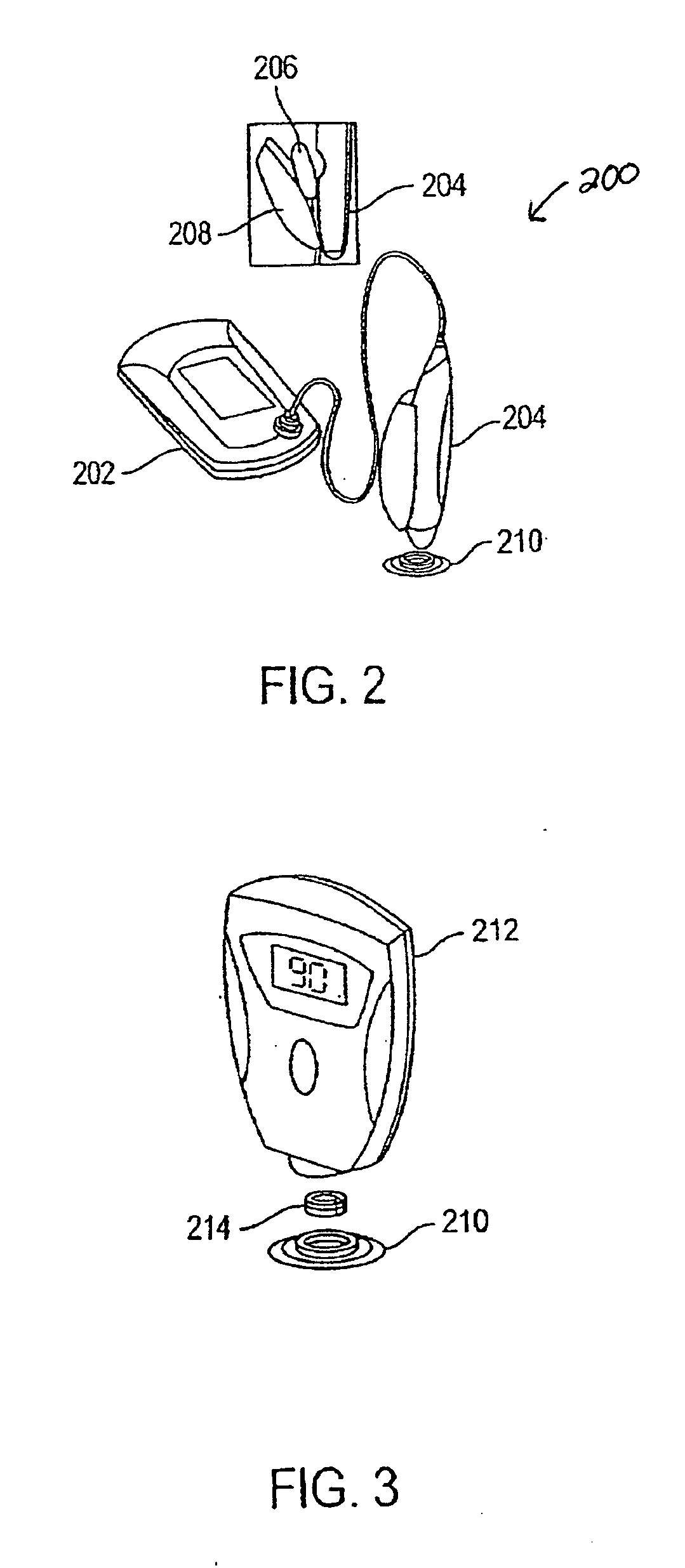Agents and methods for enhancement of transdermal transport
a technology of transdermal transport and agents, applied in the field of agents and methods for enhancing transdermal transport, can solve the problems of limited flow and volume of body fluid that can be transported across the stratum corneum, pain and inconvenience of using blood for frequent monitoring, etc., and achieve the effect of improving transdermal transport and enhancing transdermal transpor
- Summary
- Abstract
- Description
- Claims
- Application Information
AI Technical Summary
Benefits of technology
Problems solved by technology
Method used
Image
Examples
example 1
[0122] The following example does not limit the present invention in any way, and is intended to illustrate an embodiment of the present invention.
[0123] The following is a description of experiments which implemented painless extraction, collection, and analysis of body fluid to determine body fluid glucose concentration in a human using a hyperosmotic extraction fluid and comparing this condition with iso-osmotic extraction fluid, in accordance with one embodiment of the present invention. Although body fluid glucose concentration serves as an example to demonstrate feasibility, other analytes are within the contemplation of the present invention. In addition, multiple analytes may be measured and / or analyzed simultaneously, in parallel, or in series, and results from these multiple measurements may be used in combination with algorithms, for example, to increase the accuracy or precision or both of measurements. As may be recognized by one of ordinary skill in the art, these ste...
example 2
[0190] In this example, sonication parameters were evaluated to identify a desirable skin pretreatment agent.
[0191] This experiment entailed screening of skin treatment agents to enable reproducible and painless ultrasound-induced skin permeation. The agents tested were isopropanol, Lippo gel (Hawkins Pharmaceuticals, Inc., Minneapolis, Minn.), phosphate buffered saline (PBS), pyrrolidone carboxylate (Sigma, Inc.), taurocholic acid (sodium taurocholate, Spectrum Chemicals, Gardena, Calif.), and glycerol (Spectrum Chemicals, Gardena, Calif.). Among these, isopropanol, pyrrolidone carboxylate and taurocholic acid served as delipidation agents and phosphate buffered saline and glycerol served as hydrating agents. Lippo Gel is a commercially available skin permeation enhancer with lipid dissolution and skin hydrating agents.
[0192] The agents were dissolved in deionized water in the following concentrations: Isopropanol (70% weight / volume (w / v)), pyrrolidone carboxylate (1% w / v), sodiu...
example 3
[0194] This example involved a method to solvate and strip skin surface lipids using a liposoluble solvent such as alcohol followed by hydration of the epidermal corneocytes using a hydrating solvent such as glycerol. This example demonstrated that the sequence of the lipid stripping followed by the skin hydration step may be important.
[0195] Human volunteers between the ages of 20-60 were enrolled in the study. The sites of treatment were the dorsum of the hand and the anticubital of the arm.
[0196] Sonication on skin pre-treated with an alcohol wipe followed by a glycerol wipe, an alcohol wipe followed by a baby wipe, and a baby wipe alone were evaluated in this example. The alcohol wipe used contained 70% isopropanol in deionized water. Pre-packaged alcohol wipes were used for the study. The baby wipes used in the study were commercially available under the Huggies® brand name. A 5% w / v solution of pharmaceutical grade glycerol (Spectrum Chemicals, Gardena, Calif.) in sterile fi...
PUM
| Property | Measurement | Unit |
|---|---|---|
| Pressure | aaaaa | aaaaa |
| Pressure | aaaaa | aaaaa |
| Amphiphilic | aaaaa | aaaaa |
Abstract
Description
Claims
Application Information
 Login to View More
Login to View More - R&D
- Intellectual Property
- Life Sciences
- Materials
- Tech Scout
- Unparalleled Data Quality
- Higher Quality Content
- 60% Fewer Hallucinations
Browse by: Latest US Patents, China's latest patents, Technical Efficacy Thesaurus, Application Domain, Technology Topic, Popular Technical Reports.
© 2025 PatSnap. All rights reserved.Legal|Privacy policy|Modern Slavery Act Transparency Statement|Sitemap|About US| Contact US: help@patsnap.com



